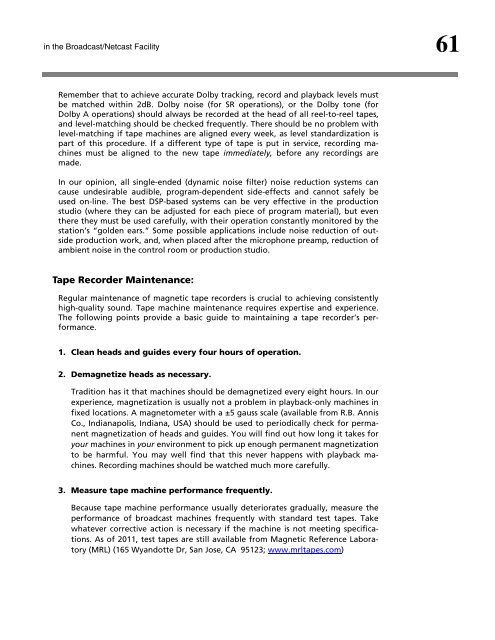Maintaining Audio Quality in the Broadcast Facility 2011 - Orban
Maintaining Audio Quality in the Broadcast Facility 2011 - Orban
Maintaining Audio Quality in the Broadcast Facility 2011 - Orban
Create successful ePaper yourself
Turn your PDF publications into a flip-book with our unique Google optimized e-Paper software.
<strong>in</strong> <strong>the</strong> <strong>Broadcast</strong>/Netcast <strong>Facility</strong> 61<br />
Remember that to achieve accurate Dolby track<strong>in</strong>g, record and playback levels must<br />
be matched with<strong>in</strong> 2dB. Dolby noise (for SR operations), or <strong>the</strong> Dolby tone (for<br />
Dolby A operations) should always be recorded at <strong>the</strong> head of all reel-to-reel tapes,<br />
and level-match<strong>in</strong>g should be checked frequently. There should be no problem with<br />
level-match<strong>in</strong>g if tape mach<strong>in</strong>es are aligned every week, as level standardization is<br />
part of this procedure. If a different type of tape is put <strong>in</strong> service, record<strong>in</strong>g mach<strong>in</strong>es<br />
must be aligned to <strong>the</strong> new tape immediately, before any record<strong>in</strong>gs are<br />
made.<br />
In our op<strong>in</strong>ion, all s<strong>in</strong>gle-ended (dynamic noise filter) noise reduction systems can<br />
cause undesirable audible, program-dependent side-effects and cannot safely be<br />
used on-l<strong>in</strong>e. The best DSP-based systems can be very effective <strong>in</strong> <strong>the</strong> production<br />
studio (where <strong>the</strong>y can be adjusted for each piece of program material), but even<br />
<strong>the</strong>re <strong>the</strong>y must be used carefully, with <strong>the</strong>ir operation constantly monitored by <strong>the</strong><br />
station’s “golden ears.” Some possible applications <strong>in</strong>clude noise reduction of outside<br />
production work, and, when placed after <strong>the</strong> microphone preamp, reduction of<br />
ambient noise <strong>in</strong> <strong>the</strong> control room or production studio.<br />
Tape Recorder Ma<strong>in</strong>tenance:<br />
Regular ma<strong>in</strong>tenance of magnetic tape recorders is crucial to achiev<strong>in</strong>g consistently<br />
high-quality sound. Tape mach<strong>in</strong>e ma<strong>in</strong>tenance requires expertise and experience.<br />
The follow<strong>in</strong>g po<strong>in</strong>ts provide a basic guide to ma<strong>in</strong>ta<strong>in</strong><strong>in</strong>g a tape recorder’s performance.<br />
1. Clean heads and guides every four hours of operation.<br />
2. Demagnetize heads as necessary.<br />
Tradition has it that mach<strong>in</strong>es should be demagnetized every eight hours. In our<br />
experience, magnetization is usually not a problem <strong>in</strong> playback-only mach<strong>in</strong>es <strong>in</strong><br />
fixed locations. A magnetometer with a ±5 gauss scale (available from R.B. Annis<br />
Co., Indianapolis, Indiana, USA) should be used to periodically check for permanent<br />
magnetization of heads and guides. You will f<strong>in</strong>d out how long it takes for<br />
your mach<strong>in</strong>es <strong>in</strong> your environment to pick up enough permanent magnetization<br />
to be harmful. You may well f<strong>in</strong>d that this never happens with playback mach<strong>in</strong>es.<br />
Record<strong>in</strong>g mach<strong>in</strong>es should be watched much more carefully.<br />
3. Measure tape mach<strong>in</strong>e performance frequently.<br />
Because tape mach<strong>in</strong>e performance usually deteriorates gradually, measure <strong>the</strong><br />
performance of broadcast mach<strong>in</strong>es frequently with standard test tapes. Take<br />
whatever corrective action is necessary if <strong>the</strong> mach<strong>in</strong>e is not meet<strong>in</strong>g specifications.<br />
As of <strong>2011</strong>, test tapes are still available from Magnetic Reference Laboratory<br />
(MRL) (165 Wyandotte Dr, San Jose, CA 95123; www.mrltapes.com)



![[PDF] Using the ITU BS.1770-2 and CBS Loudness Meters ... - Orban](https://img.yumpu.com/50629372/1/190x245/pdf-using-the-itu-bs1770-2-and-cbs-loudness-meters-orban.jpg?quality=85)






![[PDF] Optimod-FM Feature Comparison - Orban](https://img.yumpu.com/41741615/1/190x245/pdf-optimod-fm-feature-comparison-orban.jpg?quality=85)






